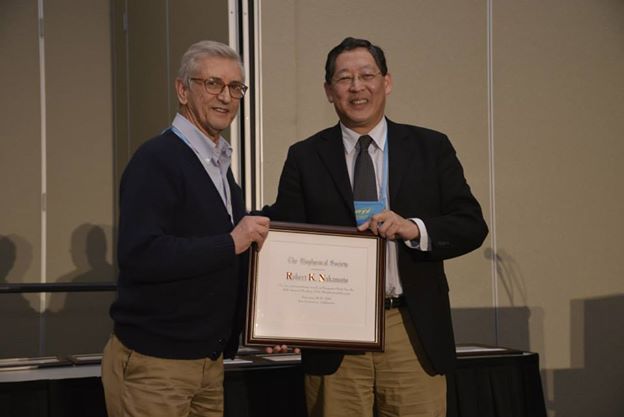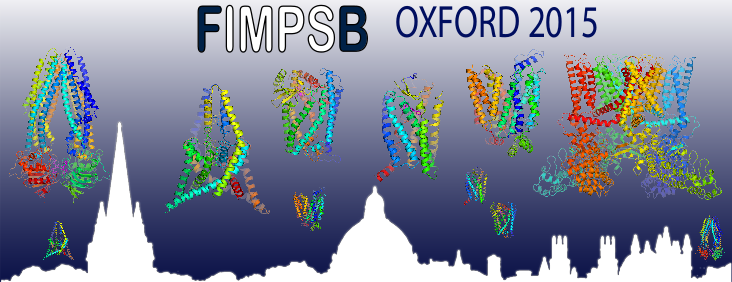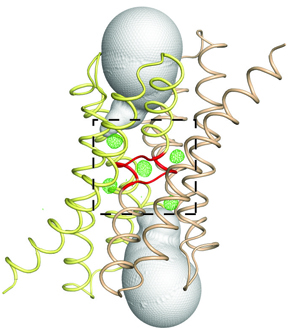

MPSDC Awards: Francisco Bezanilla, Past President presenting an award to Robert Nakamoto.
(Click to enlarge)
The Membrane Protein Structural Dynamics Consortium is always very well represented at the annual Biophysical Society meeting, as can be seen by Klaus Schulten‘s National Lecture in 2015 as well as at the level of participants in a remarkably large number of workshops, symposia, and presentations. This is also reflected in Consortium members being actively involved at the leadership level, including Francisco Bezanilla‘s tenure as Biophysical Society President from 2012 to 2014 and Robert Nakamoto and Olga Boudker‘s service in the current Biophysical Society leadership council.
On August 31, 2015 the Biophysical Society announced that MPSDC Chair Eduardo Perozo was elected as a 2016 Society Fellow. This award honors the Society’s distinguished members who have demonstrated excellence in science, contributed to the expansion of the field of biophysics, and supported the Biophysical Society. The Fellows will be honored at the Awards Ceremony during the Biophysical Society’s 60th Annual Meeting on Monday February 29, 2016 at the Los Angeles Convention Center in Los Angeles, California. Perozo was elected for his leadership and fundamental contributions in ion channel biophysics.
At next year’s meeting in Los Angeles, MPSDC members will participate in a number of specialty symposia and workshops organized by the Biophysical society (more information on the nature of these symposia and workshops can be found on the Biophysical Society meeting website here). We would like to highlight the following in particular (though there are and will certainly be more ways in which Consortium members are involved with the meeting):
- Francisco Bezanilla (University of Chicago) is participating in a symposium on Voltage Sensing and Gating.
- Olga Boudker (Weill Cornell Medical College) is receiving the Michael and Kate Bárány Award during the meeting’s award symposium. During this session, award recipients are recognized and each give a short talk about the work for which they are being recognized. Congratulations, Olga!
- Yifan Cheng (University of California, San Francisco) is co-chairing the Cryo-EM Subgroup 2016 Symposium
- Claudio Grosman(UIUC) is participating in a symposium on Pentameric Ligand-gated Ion Channels: New Insights from Structure and Function.
- Benoît Roux (University of Chicago) is participating in a workshop about Computational Methods for Ion Permeation and Selectivity
- Emad Tajkhorshid (UIUC) will once again be chairing the Permeation & Transport Subgroup 2015 Symposium. He chaired the same subgroup last year.

Last year, MPSDC member and one of our keynote speakers at Frontiers in Membrane Protein Structural Dynamics 2014 Klaus Schulten (UIUC) gave the prestigious National Lecture. The National Lecturer is the highest award given each year by the Biophysical Society. Dr. Schulten’s 2015 National Lecture lecture can be viewed in full here.
See also: interviews from the 59th Biophysical Society Meeting with 2015 National Lecturer Klaus Schulten and Harel Weinstein.
See also: interviews from the 58th Biophysical Society Meeting with Francisco Bezanilla, Past President and Robert Nakamoto, Chair of the 2014 BPS Program Committee.


 Not just anything is allowed to enter the nucleus, the heart of eukaryotic cells where, among other things, genetic information is stored. A double membrane, called the “nuclear envelope,” serves as a wall, protecting the contents of the nucleus. Any molecules trying to enter or exit the nucleus must do so via a cellular gatekeeper known as the nuclear pore complex (NPC), or pore, which exists within the envelope.
Not just anything is allowed to enter the nucleus, the heart of eukaryotic cells where, among other things, genetic information is stored. A double membrane, called the “nuclear envelope,” serves as a wall, protecting the contents of the nucleus. Any molecules trying to enter or exit the nucleus must do so via a cellular gatekeeper known as the nuclear pore complex (NPC), or pore, which exists within the envelope. Fluoride protects our teeth against cavity-causing bacteria by making our teeth stronger. But what if we could find a way to trap fluoride ions (the negatively charged form of the chemical element fluorine) inside bacteria? At the right concentration, fluoride ions are highly toxic to bacteria, wreaking havoc on their proteins and disrupting critical cellular functions. Bacteria, however, can fight back, exporting the toxic fluoride ions out using specialized proteins called fluoride-specific ion channels.
Fluoride protects our teeth against cavity-causing bacteria by making our teeth stronger. But what if we could find a way to trap fluoride ions (the negatively charged form of the chemical element fluorine) inside bacteria? At the right concentration, fluoride ions are highly toxic to bacteria, wreaking havoc on their proteins and disrupting critical cellular functions. Bacteria, however, can fight back, exporting the toxic fluoride ions out using specialized proteins called fluoride-specific ion channels. On August 31, 2015 the Biophysical Society announced that MPSDC Chair
On August 31, 2015 the Biophysical Society announced that MPSDC Chair 





